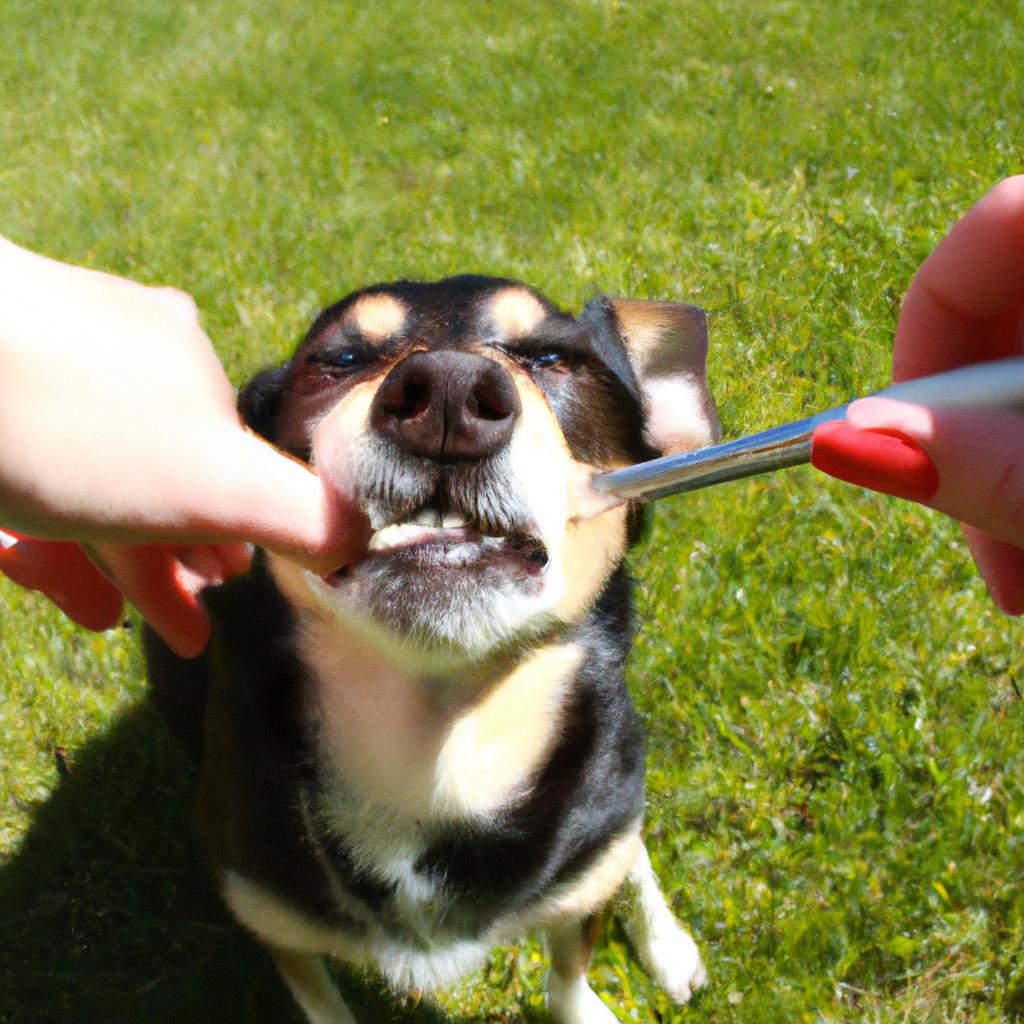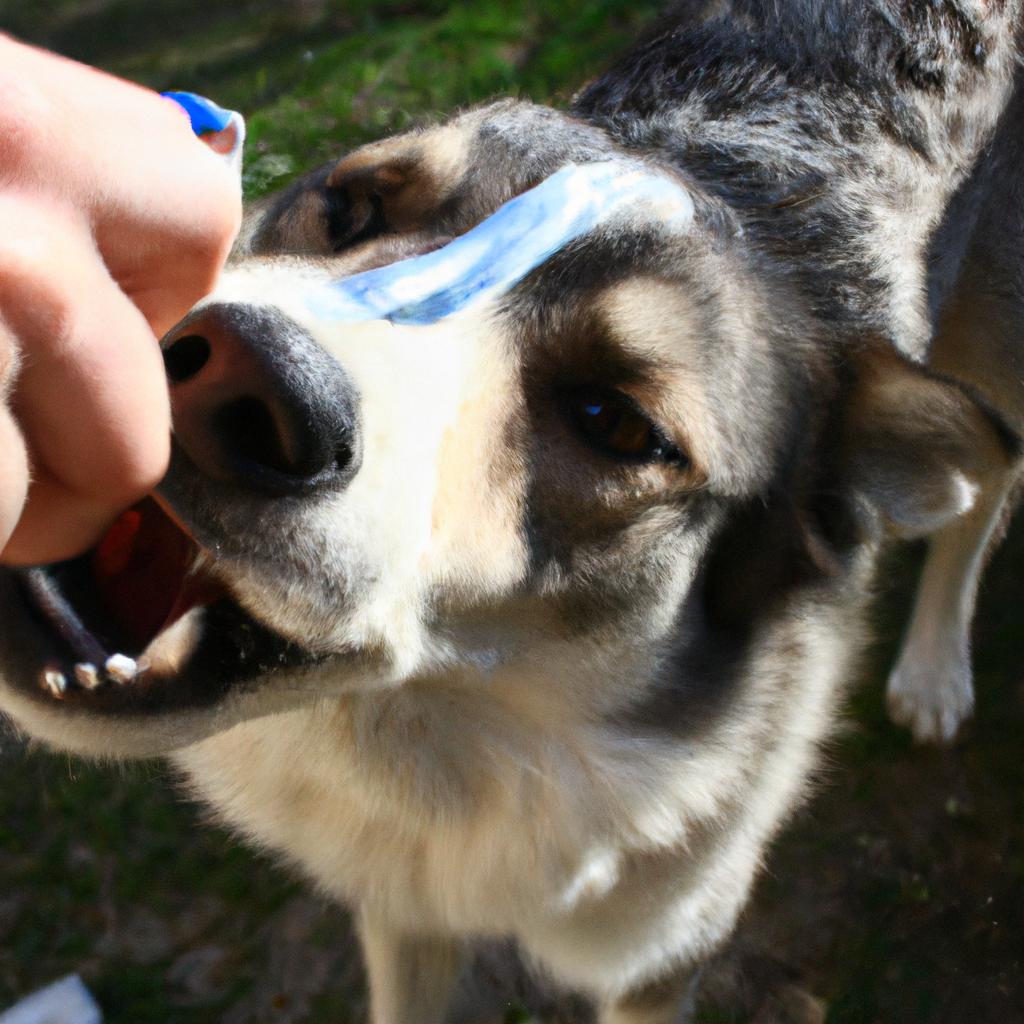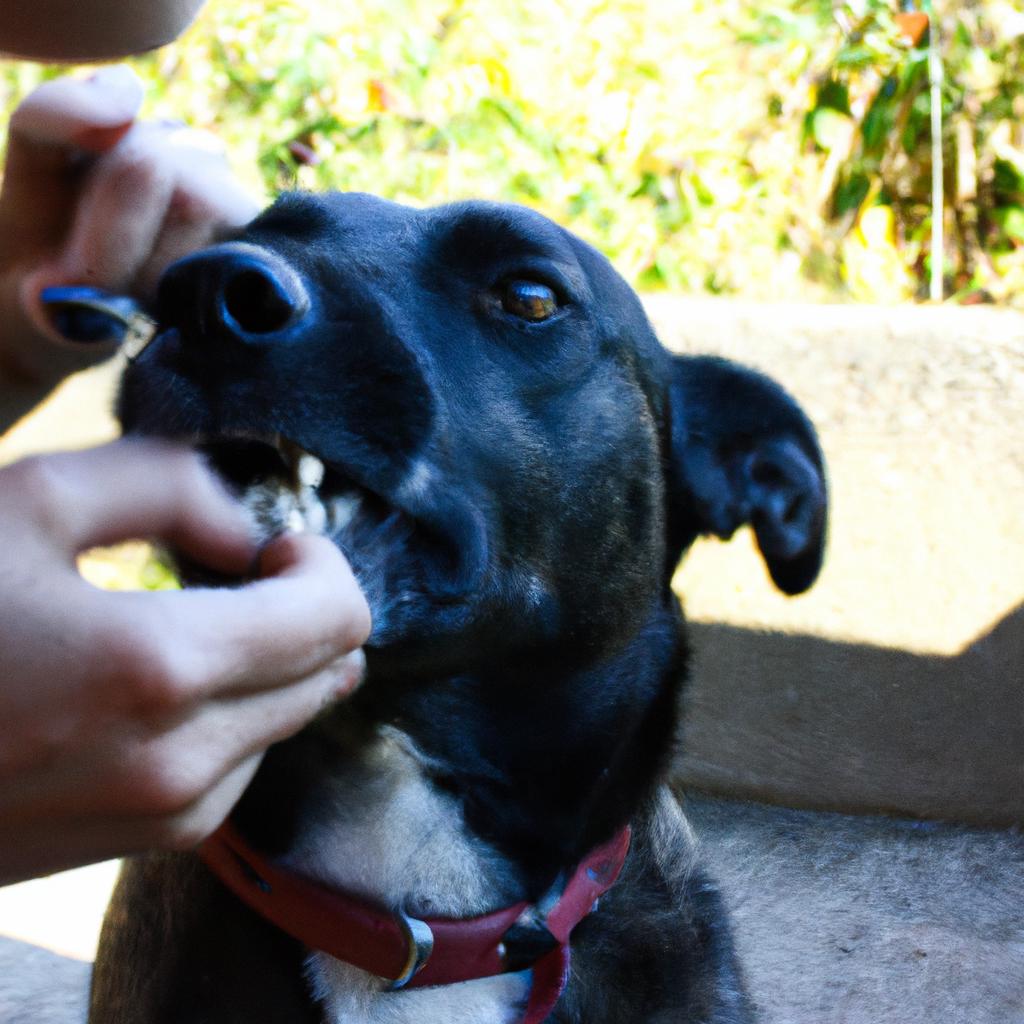Techniques for Effective Teeth Brushing: Dog Grooming Salon’s Guide

Effective teeth brushing is an essential aspect of maintaining a dog’s oral hygiene. Just like humans, dogs can also develop dental problems such as plaque buildup, tartar accumulation, and gum disease if their teeth are not properly cared for. For instance, consider the case of Max, a seven-year-old Golden Retriever. Despite regular visits to the veterinarian, Max’s owner noticed that his breath had become noticeably foul and he was showing signs of discomfort while eating. Upon examination, it was discovered that Max had developed severe periodontal disease due to inadequate dental care. This example highlights the importance of implementing effective techniques for teeth brushing in order to ensure optimal oral health for our canine companions.
To achieve successful teeth brushing outcomes, various techniques have been established by dog grooming salons. These techniques aim to address different aspects of the process including proper positioning of the dog, selection of appropriate tools and toothpaste, and utilization of effective brushing methods. Firstly, positioning plays a crucial role in ensuring both the comfort and cooperation of the dog during teeth brushing sessions. By placing the dog at eye level or slightly higher on a sturdy surface such as a table or countertop with non-slip material underneath them, groomers can establish better control over their movements and reduce potential slippage or resistance.
Secondly, the selection of the right tools and toothpaste is important for effective teeth brushing. Dog-specific toothbrushes with soft bristles are recommended to prevent any potential damage to the dog’s gums or teeth. It is crucial to avoid using human toothpaste as it can be harmful if ingested by dogs. Instead, specially formulated dog toothpaste should be used, which comes in various flavors that appeal to dogs and make the brushing experience more enjoyable for them.
Next, implementing proper brushing methods is essential for removing plaque and maintaining oral health. Groomers should start by gently lifting the dog’s lips and using small circular motions to brush along the gumline. Paying particular attention to the back molars and areas where plaque tends to accumulate is important. Additionally, gradually introducing teeth brushing from a young age helps dogs become accustomed to the process and may reduce resistance or stress during future sessions.
Lastly, consistency is key when it comes to teeth brushing. Ideally, dogs should have their teeth brushed daily or at least three times a week to maintain optimal oral hygiene. Regular veterinary check-ups should also be scheduled to monitor any potential dental issues and provide professional cleanings if necessary.
In summary, effective teeth brushing techniques are crucial for maintaining a dog’s oral health. Proper positioning, selecting appropriate tools and toothpaste, utilizing effective brushing methods, and maintaining consistency are all essential aspects of this process. By following these guidelines, dog owners can ensure that their furry companions enjoy good oral hygiene and avoid dental problems such as plaque buildup, tartar accumulation, and gum disease.
Selecting the right toothbrush for your dog
Imagine this scenario: you bring home a brand new toothbrush, excited to start brushing your dog’s teeth regularly. However, when you attempt to use it, you realize that it is too big and cumbersome for your furry friend’s mouth. Frustrated, you wonder if there was a way to avoid this situation altogether. This is where selecting the right toothbrush for your dog becomes crucial.
To ensure effective teeth brushing, it is essential to choose a toothbrush specifically designed for dogs. Here are some key factors to consider:
-
Size: Dogs come in various shapes and sizes, so it is important to select a toothbrush appropriate for your pet’s mouth. A brush with a small head and soft bristles will allow for easy maneuverability and gentle cleaning.
-
Handle Grip: Dogs can be wiggly during grooming sessions, making it challenging to maintain control of the toothbrush. Look for a toothbrush with an ergonomic handle grip that provides stability and prevents slippage.
-
Bristle Texture: Just like humans, dogs have different preferences when it comes to bristle texture. Some may prefer softer bristles while others may require firmer ones for better plaque removal. Experimentation can help determine which type works best for your dog.
-
Durability: Dogs tend to chew on things they find interesting or unfamiliar, including their own toothbrushes! Opt for a durable toothbrush made from quality materials that can withstand chewing without breaking apart easily.
Considering these factors will not only make the teeth brushing experience more comfortable and enjoyable for your dog but also contribute to its overall oral health.
Now let’s move on to the next step: using toothpaste formulated for dogs…
Using toothpaste formulated for dogs
Imagine a scenario where a pet owner, let’s call her Sarah, regularly brushes her dog Bella’s teeth using an appropriate toothbrush and toothpaste formulated for dogs. By following this consistent brushing routine, Sarah provides Bella with numerous benefits that contribute to overall dental health.
A consistent brushing routine can help prevent dental issues such as plaque buildup, gum disease, and bad breath in dogs. Here are some key reasons why establishing a regular brushing routine is essential:
- Preventing Plaque Buildup: Regular brushing helps remove food particles and bacteria from your dog’s teeth, preventing the formation of plaque. This reduces the risk of tartar accumulation and potential oral infections.
- Maintaining Healthy Gums: Proper oral hygiene promotes healthy gums by reducing inflammation and preventing periodontal diseases. A regular brushing routine stimulates blood flow to the gums, keeping them strong and resilient.
- Freshening Breath: Dogs with poor dental hygiene often develop bad breath due to bacterial growth in their mouths. Regular brushing eliminates odor-causing bacteria, resulting in fresher breath for your furry friend.
- Saving Money on Veterinary Dental Procedures: By maintaining good oral hygiene through consistent brushing, you may reduce the need for costly veterinary dental treatments like professional cleanings or extractions.
To further emphasize the importance of proper dental care for dogs, consider the following table showcasing statistics related to canine oral health:
| Dental Health Facts | Impact |
|---|---|
| 80% of dogs show signs of dental disease | Untreated dental problems can lead to pain and discomfort |
| Poor oral hygiene can affect overall | Difficulty eating |
| health | Digestive issues |
| Weakened immune system | |
| Decreased lifespan |
In summary, establishing a consistent brushing routine for your dog plays a vital role in maintaining optimal dental health. By preventing plaque buildup, promoting healthy gums, freshening breath, and potentially saving money on veterinary dental procedures, you are ensuring your furry companion’s overall well-being.
Transitioning into the next section about understanding the correct brushing technique, it is essential to explore effective methods that will maximize the benefits of regular brushing for your dog.
Understanding the correct brushing technique
Building on the importance of using toothpaste formulated for dogs, let us delve into understanding the correct brushing technique to ensure effective teeth cleaning. By following these guidelines, dog owners can promote good oral hygiene and prevent dental issues in their furry companions.
The key to successful teeth brushing lies in mastering the correct technique. Let’s consider an example scenario where a dog owner named Sarah is struggling with her canine friend, Max, during brushing sessions. Despite her best efforts, she finds it challenging to clean Max’s teeth thoroughly. Understanding the correct brushing technique can greatly help individuals like Sarah overcome such obstacles.
To achieve optimal results while brushing your dog’s teeth, keep in mind the following pointers:
- Maintain a gentle touch: Apply light pressure when brushing your dog’s teeth to avoid causing discomfort or injury.
- Use circular motions: Instead of scrubbing back and forth, use small circular motions along the gum line and tooth surfaces for more effective plaque removal.
- Focus on all sides of the mouth: Ensure that you brush both the outer and inner surfaces of your dog’s teeth for comprehensive cleaning.
- Gradual introduction: If your dog is resistant to having its teeth brushed, introduce toothbrushing gradually by starting with shorter sessions and rewarding positive behavior.
Table: Importance of Correct Brushing Technique
| Benefits | Explanation |
|---|---|
| Thorough Plaque Removal | Circular motions aid in dislodging plaque from hard-to-reach areas around gums and teeth. |
| Prevention of Gum Disease | Regularly brushing all sides helps reduce bacteria buildup and lowers risk of gum disease. |
| Fresher Breath | Effective removal of food particles decreases odor-causing bacteria, resulting in fresher breath. |
| Better Overall Oral Health | Implementing proper techniques contributes to maintaining healthy gums and strong teeth. |
By adhering to these recommended practices, pet owners can establish a regular brushing routine that ensures their dog’s oral health is well-maintained. This, in turn, reduces the likelihood of dental issues and promotes overall wellbeing.
Dealing with resistance or fear during brushing can be challenging for many pet owners. Let’s explore effective strategies to overcome these hurdles and ensure a positive teeth cleaning experience for both you and your furry friend.
Dealing with resistance or fear during brushing
Understanding the Correct Brushing Technique
Now, let’s explore how to handle resistance or fear during brushing and ensure a positive experience for both you and your furry friend.
Imagine this scenario: You have a new client named Max, a 2-year-old Labrador Retriever who becomes anxious whenever his teeth are brushed. This is not an uncommon situation among dogs, as they may feel uncomfortable with unfamiliar sensations in their mouths. It’s crucial to approach such situations with patience and gentle techniques.
To effectively deal with resistance or fear during brushing, consider the following:
- Gradual Desensitization: Introduce the toothbrush slowly by allowing your dog to sniff it before starting any brushing motion. Begin by gently touching their gums and gradually progress into longer strokes over time.
- Positive Reinforcement: Reward your dog with treats or praises after each successful brushing session. This helps associate the activity with positive experiences, encouraging cooperation in future sessions.
- Distraction Techniques: Engage your dog’s attention by offering them a favorite toy or treat while you brush their teeth. This can help divert their focus from any discomfort they may be feeling.
- Professional Assistance: If despite your efforts, your dog continues to resist or show signs of extreme anxiety during teeth brushing, consult a professional groomer or veterinarian for additional guidance.
By employing these strategies, you can create a more relaxed environment for Max and other dogs alike, ensuring that their dental care routine remains stress-free and enjoyable.
Now that we’ve explored effective techniques for handling resistance or fear during teeth brushing, let’s move on to establishing a regular teeth brushing routine at home
Establishing a regular teeth brushing routine
Dealing with resistance or fear during brushing can be a challenge for many dog owners. Let’s consider the case of Max, a five-year-old Labrador Retriever who initially displayed signs of anxiety and reluctance when it came to teeth brushing. Despite his owner’s best efforts, Max would become tense, try to escape, and occasionally show aggression towards the toothbrush. This scenario is not uncommon, but there are techniques that can help address these issues and establish a regular teeth brushing routine.
To alleviate resistance or fear during brushing, it is crucial to create a positive association with the activity. One effective approach is gradual desensitization. Start by introducing your dog to the toothbrush without any toothpaste and allow them to sniff and explore it at their own pace. Once they appear more comfortable, gradually progress by gently touching their gums with the brush bristles using circular motions. Rewarding your dog with treats or praise after each successful session will reinforce positive behavior.
Here are some additional strategies you can employ:
- Use flavored toothpaste: Dogs often find this more enjoyable than traditional mint-flavored paste.
- Opt for soft-bristled brushes: These are gentler on your dog’s gums and may lessen discomfort.
- Consider finger brushes or dental wipes: Some dogs prefer these alternatives as they provide a different tactile sensation.
- Seek professional help if needed: If your dog continues to exhibit extreme resistance or fear despite your efforts, consult with a veterinarian or professional dog trainer experienced in handling behavioral issues.
Keeping these techniques in mind, let us now move on to establishing a regular teeth brushing routine.
Table: Benefits of Regular Teeth Brushing
| Benefit | Explanation |
|---|---|
| Prevents plaque | Removing food particles and bacteria helps prevent plaque |
| Freshens breath | Regular brushing reduces bad breath caused by oral bacteria |
| Maintains gum health | Brushing stimulates healthy blood flow and prevents gum disease |
| Promotes overall health | Good oral hygiene contributes to your dog’s overall well-being |
Establishing a regular teeth brushing routine is essential for maintaining your dog’s dental health. By incorporating the techniques mentioned earlier, you can gradually increase their comfort level and make brushing an enjoyable experience for both of you. Remember that patience, consistency, and positive reinforcement are key in this process.
Now let us explore how supplementing brushing with dental chews or toys can further enhance your dog’s oral care routine
Supplementing brushing with dental chews or toys
Building on the importance of establishing a regular teeth brushing routine, another effective technique for maintaining optimal dental hygiene in dogs is supplementing brushing with dental chews or toys. By incorporating these supplementary measures into your pet’s oral care regimen, you can enhance their overall dental health and reduce the risk of periodontal disease. Let us explore how this approach can benefit your furry friend.
Example: Consider Max, a four-year-old Labrador Retriever who has been diligently following his daily brushing routine. However, despite his owner’s best efforts, Max still experiences mild tartar buildup on his molars. To address this issue, Max’s owner decided to introduce dental chews as an additional measure to promote better oral health.
Paragraph 1:
Supplementing regular teeth brushing with dental chews or toys offers several advantages. Firstly, chewing on specially designed products stimulates saliva production, which helps wash away bacteria and prevent plaque formation. Additionally, the mechanical action of gnawing on chew treats creates friction against the tooth surface, aiding in removing accumulated debris and promoting healthier gums. This process mimics natural behaviors like chewing bones or grass that wild canines engage in to maintain their dental hygiene.
Bullet Point List (evoking emotional response):
- Enhanced freshness: Dental chews often have breath-freshening properties that help combat bad breath, leaving your dog’s mouth smelling fresher.
- Mental stimulation: Gnawing on chew toys provides mental stimulation for dogs by engaging their senses and relieving anxiety or boredom.
- Long-lasting entertainment: Dental chews are designed to be durable and long-lasting, providing hours of enjoyment for your canine companion.
- Improved bonding opportunities: Engaging your dog with interactive chew toys allows for moments of playfulness and strengthens the bond between you and your pet.
Paragraph 2:
When selecting dental chews or toys for your dog, it is essential to consider factors such as size appropriateness, texture, and ingredients. Opt for products specifically designed for your dog’s breed or size to ensure maximum effectiveness without the risk of choking hazards. Look for options with a textured surface that helps remove plaque and tartar as your dog chews.
Table (evoking emotional response):
| Brand | Features | Flavors Available | Price Range |
|---|---|---|---|
| Chew-A-Dent | Natural rubber material | Chicken, beef, mint | $10 – $15 per toy |
| HealthyBite | Nylon bristles | Bacon, peanut butter | $8 – $12 per chew |
| FreshDental | Dual-action design | Mint, parsley | $12 – $18 per pack |
| PupSmile | Antimicrobial properties | Blueberry, vanilla | $15 – $20 per toy |
Paragraph 3:
Incorporating dental chews or toys into your dog’s oral care routine provides an additional layer of protection against dental issues. However, it is important to remember that these supplementary measures should not replace regular teeth brushing but rather complement it. By combining daily toothbrushing sessions with the mechanical action and dental benefits offered by appropriate chew treats or toys, you can significantly contribute to maintaining your furry friend’s dental health in between veterinary cleanings.
By consistently implementing these techniques outlined above—establishing a regular teeth brushing routine and supplementing it with dental chews or toys—you are taking proactive steps to promote optimal oral health for your beloved canine companion.






